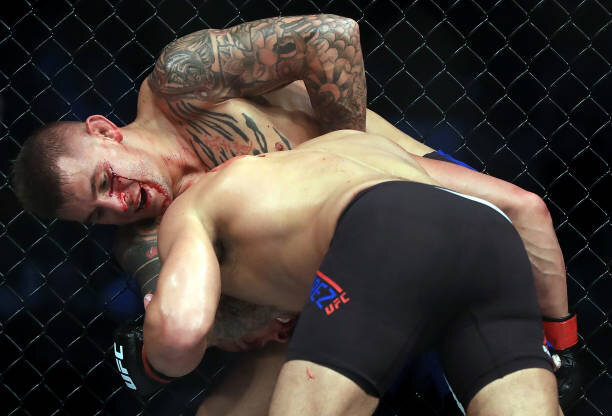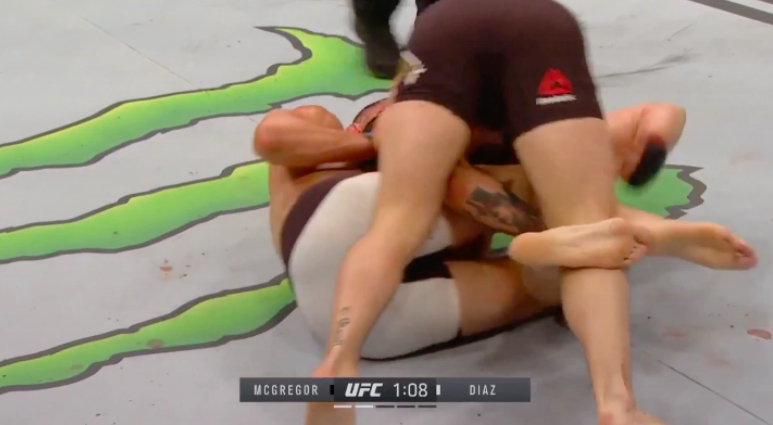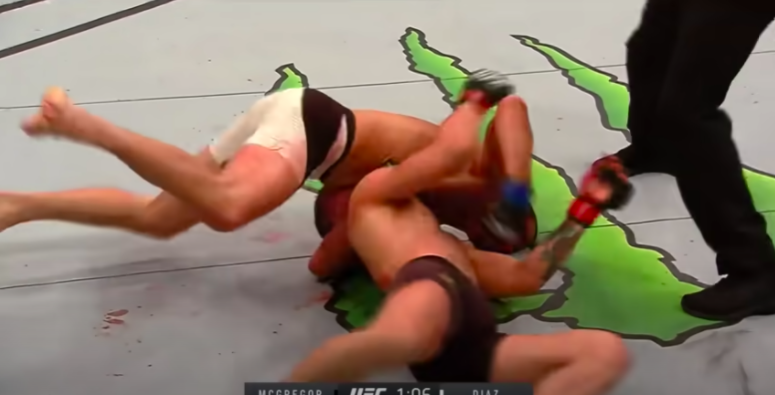GUEST POST: Conor McGregor, Dustin Poirier, & the Guillotine
Photo by Ronald Martinez/Getty Images
The following article is a guest submission from friend of the site Joe Mayall (@JoeMayall on Twitter), an under-the-radar MMA analyst. You can read more of Joe’s work on his personal blog, http://JoeWrote.com
Opinions expressed in this piece are the author’s alone, and do not necessarily reflect the views of The Fight Site staff.
***
While analysis often focuses on the successful strategies and techniques of two fighters, (say, Ronda Rousey’s linear pressure against Holly Holm’s circular footwork), there are occasions when historically ineffective practices warrant examination. McGregor vs. Poirier II is such a time.
Although it has yet to bring him a victory, Dustin Poirier loves the guillotine choke. Chasing it as Ahab chased the Whale, he’s used it against the toughest competitors, from Khabib Nurmagomedov, to Eddie Alvarez, to Dan Hooker. Ben Kohn and black belt Gene Sakirski broke down his best attempt vs. Nurmagomedov.
On the other side of the coin is Conor McGregor. Often maligned as a sub-par grappler (The Fight Site doth protest) McGregor deserves credit for his crafty guillotine escape, which helped him capture the featherweight belt. But as we’ll see, his defense is fallible, and has been overcome before.
If Poirier has been studying McGregor’s response to front chokes (which, we certainly hope he has), this bout could be his best chance at finally winning via guillotine.
A Tale of Two Escapes
First, let’s look at a successful Conor McGregor guillotine escape. This clip comes to us from round two of McGregor’s bout with Chad Mendes, back in 2015.
After taking McGregor down, Mendes starts to pass. As he moves to half guard, a scramble ensues. Perhaps worrying that he was destined for a KO loss on the feet, Mendes sits for a guillotine. With his left arm as the choking arm, Mendes falls to his left hip and throws his right leg high, hoping to ensnare the Irishman in the strangle.
As soon as Mendes falls back, McGregor dives to his right, outside of Mendes’s guard. With his back on the mat, the strangle is off-angle and ineffective.
Like a zombie from the grave, McGregor’s right hand punches skyward, across Mendes’s body to his right armpit.
McGregor was aiming to establish a reverse underhook with his right arm, pinning Mendes and taking top position. He’s a bit slow though, so Mendes was able to scramble to his knees and avoid the pin. Still, McGregor escapes the choke and the bottom position.
While the exchange may look like a random scramble arising from blood, sweat, and exhaustion, it is not. This was a pre-planned and thoroughly drilled escape from McGregor. While he didn’t secure top position, the escape technique enabled Conor to safely return to his feet, where a knockout victory would soon follow.
Now let’s look at how Nate Diaz countered this same escape during McGregor vs. Diaz I. Ben Kohn has previously broken this sequence down in depth. After being thoroughly wobbled, McGregor initiates the grappling with a Hail Mary double leg (“Oh, you’re a wrestler now?”)
Just like Chad Mendes did, Diaz wraps McGregor’s neck with his left arm and falls to his left hip. Initially, Diaz had McGregors’s left arm trapped in a arm-in guillotine situation. Outside of Diaz’s guard, McGregor walks to his left, hoping to escape the choke and take side control. But Diaz, being the crafty BJJ black belt that he is, manages to snake his bottom leg behind McGregors’s knee, slowing him down.
With his leg stifling McGregor’s movement, Diaz switches his grip to a power-guillotine. With his right hand reinforcing his left, Diaz drives his arms up into McGregor’s neck, tightening the strangle and forcing the Irishman over.
As he’s rolled to his back, McGregor tries the same escape he used against Mendes. As soon as his back hits the mat, his right arm shoots up and across, looking to get under Diaz’s right armpit and establish the pin.
With over 825,000 pay-per-views buys, McGregor vs. Mendes was a popular event. As evidenced by Diaz’s pre-set counter to McGregors’s escape, the Diaz household was one of these viewers.
As soon as he feels McGregor escape the strangle, Diaz does what separates black belts from the rest — he lets go, and moves on to the next technique. As the zombie arm rises, Diaz is already on his knees (see above). Instead of McGregor’s arm getting under his right armpit, Diaz sneaks his right under McGregor’s armpit and around his back.
This both counters McGregor’s escape and pins him on the bottom. For those counting at home, that’s birds: 2, stone: 1.
From there, the rest is history. Diaz moves to mount and begins beating Conor like the garage heavy bag you set up after the gyms closed down. Forced to turn, McGregor gave up his back, and Diaz secured the rear naked choke, snapping McGregor’s legendary fifteen fight win streak.
McGregor’s guillotine escape was effective, but as Nate Diaz showed, there’s a counter. Now, let’s look at Dustin Poirier’s use of the guillotine, and how an “attack-against-defense” scenario might play out between these two combatants.
The Diamond Under Pressure
Although he has yet to finish one, Dustin Poirier loves guillotines (specifically, the arm-in variation).
In the below montage, we see the crux of Poirier’s guillotine issues. Notice how he wraps the guillotine and jumps guard without defending the opponent’s shot. Whether against the fence or out in the open, Poirier makes no effort to sprawl or dig underhooks. This means he’s attacking the neck while his opponent is in on his hips, which depreciates the chance of success.
While it’s entirely possible to finish a guillotine without sprawling, its much more difficult. The choke is often rushed, meaning the grip isn’t secure, and the opponent’s head can pop out.
This isn’t always the case (Poirier’s guillotine against Khabib was deep, but we all know how that turned out), but Poirier is fighting the upper echelon of one of the toughest divisions, where every millimeter counts. And as evidenced by the goose egg number of successful guillotines, it’s fair to say the attack-first strategy isn’t working.
For contrast, let’s look at a successful guillotine. Here we see Dustin Kimura (no relation) shoot a takedown against Mitch Gagnon. Notice how Gagnon stuffs Kimura’s shot with underhooks and a sprawl, driving both men to the mat. With Kimura’s takedown neutralized and his momentum stuffed, Gagnon wraps the neck and jumps for the choke. It’s deep, and Kimura is sent to Valhalla.
Now take another look at Poirier jumping for a guillotine without defending Eddie Alvarez’s shot. He doesn’t stop Alvarez’s momentum with underhooks and a sprawl, so the choke is rushed. We see Alvarez regain posture, which helped him escape.
It’s worth repeating it’s not necessary to achieve the full sprawl before jumping for the guillotine, just that doing so increases the chance of success. Charles Oliveira has several wins via guillotine without sprawling, but he pursues the choke when his opponent is stationary, not when they’re blasting forward.
With a poor takedown defense percentage of 60% (for context, McGregor, who has long been critiqued for sub-par wrestling, has 70% TDD efficacy), Poirier’s fondness of the guillotine is a chicken-or-egg question. Does he jump for guillotines without stopping his opponents’ shots because he knows he can’t defend takedowns? Or does he truly believe he can get the submission, so he gives up the takedown to pursue the finish? Regardless, the result is the same.
A Movable Object Meets a Stoppable Force
On January 23rd, Dustin Poirier, who favors but has yet to finish a guillotine, will fight Conor McGregor, whose guillotine escape has been noted, documented, and defeated. So, what happens when a movable object meets a stoppable force?
The first possibility is these pugilists give us a spectacular striking match, and the guillotine never comes into play. In that case, you have permission to scold me for wasting your time (@joemayall on twitter).
But, if we’re fortunate enough to see the guillotine arise, it’ll be interesting. As we’ve seen, Poirier initiates guillotines when an opponent shoots for a takedown, which McGregor rarely does (save for if he’s damaged, a la his bout with Diaz). While the chances of McGregor shooting are slim, Poirier accredits McGregor as “by far” the hardest hitter he’s ever faced, so it’s likely he’ll be looking to place the Irishman on the floor. In that case, a guillotine scenario could surface from a wild scramble so frequent to MMA grappling, as it did in McGregor vs. Mendes.
If this battle arises, one interesting aspect will be how McGregor’s escape works against the arm-in guillotine.
Aptly named, the arm-in guillotine wraps the victim’s arm in the choke, making it harder to escape and removing the ability to punch with the trapped arm. This makes it favorable for MMA, where blood and sweat act as lubricants, and (surprise surprise), punches are allowed. Here we see Dustin Poirier uses this variation against Khabib. Notice how both Khabib’s neck and right arm are encased in the strangle.
Against both Diaz and Mendes, McGregor’s escape was against straight guillotines (where only the neck is wrapped, not the arm). But because McGregor’s escape involves jumping out of the opponent’s guard, spinning towards the top, and reaching with the arm that wouldn’t be trapped in an arm-in guillotine, it could still work against Poirier’s arm-in variation. Due to the additional control it might not be as dynamic, but it won’t be entirely nullified.
Or, maybe Poirier determined wrapping the arm-in was the blocker to success, and he’s adopted a straight guillotine style. Or perhaps he’ll use a hybrid approach like Nate Diaz and switch between the two. Regardless of the hypotheticals, if the guillotine comes into play in McGregor v. Poirier II, it will showcase which of these two fighters is able to grow and adapt, both in planning and execution.









